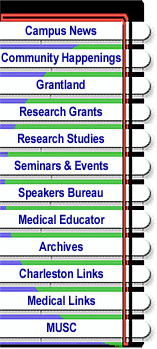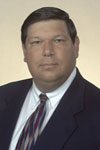


|
Deep brain stimulation offers relief from tremorsA new surgical treatment for tremor—an involuntary rhythmic shaking of the limbs—is now being performed at MUSC.During the procedure, called deep brain stimulation (DBS), in which a wire is inserted into the area of the brain known as the thalamus. The thalamus can be thought of as a central communication for the brain where all types of information enter, get processed, and are then sent to other areas of the brain.  “A
thin, insulated wire or deep brain electrode is inserted into a very specific
area of the thalamus that is responsible for the tremor,” explained neurosurgeon
Richard Osenbach, M.D. “When small
electrical impulses are passed through the wire, the abnormal brain signals
are blocked and the tremor stops, indicating that the wire is in the proper
location within the brain.” “A
thin, insulated wire or deep brain electrode is inserted into a very specific
area of the thalamus that is responsible for the tremor,” explained neurosurgeon
Richard Osenbach, M.D. “When small
electrical impulses are passed through the wire, the abnormal brain signals
are blocked and the tremor stops, indicating that the wire is in the proper
location within the brain.”
Once the wire is placed, it's connected by an extension wire passed under the skin to an implanted pulse generator or battery (similar to a cardiac pacemaker) placed under the skin just beneath the collarbone. After the device has been implanted, it is programmed with the settings that will work the best for each individual patient. The patient is able to turn the device on or off depending on their individual requirements simply by passing a hand-held magnet over the battery. Deep brain stimulation is primarily used in patients with essential tremor—the most common movement disorder in the United States—and in patients with Parkinson’s disease in whom the tremor is the most predominant and disabling symptom. Prior to the use of deep brain stimulation for tremor, the only surgical option was to perform a thalamotomy, a procedure where a small hole is made in the area of the brain that causes the tremor. In fact, the target sites for thalamotomy and the deep brain stimulator are identical. While both of these procedures are effective in relieving tremor, the major advantage of the deep brain stimulator is the ability to regulate or “fine tune” the stimulation after the device has been implanted. This is done in the doctor’s office using a telemetry wand and a computer programmer. The other major advantage of DBS is that both sides of the brain can be treated. Normally performing thalamotomy or a deep brain stimulation relieves the tremor on the opposite side of the body. It is not possible to perform a thalamotomy on both sides of the brain. However, it is possible to place a stimulator on both sides (usually at least 3-6 months apart). “Deep brain stimulation is an exciting and useful procedure that can significantly improve the quality of life in patients who suffer from disabling tremor,” said Osenbach. “It is likely that other targets for deep brain stimulation will shortly be approved for the treatment of some of the other disabling symptoms of Parkinson’s disease and other movement disorders called dystonia.” Deep brain stimulation also has applications in the treatment of very selected chronic intractable pain conditions in which no other options exist. Studies are just beginning to investigate the use of deep brain stimulation as a treatment option for intractable epilepsy and selected psychiatric disorders such as major depression. Osenbach is currently involved in developing research protocols to enable MUSC offer this treatment under selected investigational protocols. Additionally, work is progressing on developing a multidisciplinary center of excellence for the comprehensive treatment of Parkinson’s disease as well as other movement disorders. |